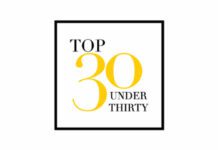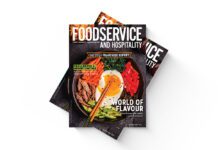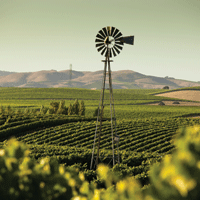Despite the economic challenges of recent years, California wine sales continue to shine
For many years, California wines enjoyed strong sales in Canada. Then four years ago the recession hit south of the border, and the price of California wines went down significantly, where it has remained. Interestingly, despite the economic challenges, diversity of product continues to grow with many wineries paying increased attention to quality by keeping oak and alcohol levels in check. Light harvests in 2010 and 2011 will likely dry up some of the excess stock that’s played a role in the aggressive discounting of the past several years but how that will affect pricing going forward remains to be seen. In the meantime, California wines continue to please customers while turning a profit for Canadian restaurants.
“California wines are strong, and they have been for some time,” says Rob Groh, owner of The Vine, a wine agency that carries many high-end California wines. “The market has benefited greatly from a weaker U.S. dollar, making California very competitive. In the early 1980s, when I worked at Mövenpick, California wines were a novelty but now they’re the number 1 or 2 region in importance among Toronto restaurants,” explains Groh.
Industry Update
LCBO’s most recent Red Book statistics as of November 2011 show sales of U.S. wines (95 per cent of which come from Cali-fornia) are up more than 11 per cent in Canada from the previous year. Licensee sales are up more than two per cent nationally. The top three sellers (nationally) are Gallo White Zinfandel, Carlo Rossi Burgundy and Barefoot Pinot Grigio, all of which fall into the under $10 “cheap and cheerful” category. However, in fourth position is the Folie à Deux Ménage à Trois red, with an average selling price across Canada of $19 and an amazing national trend volume increase of 62 per cent. Licensee sales for that listing are up 9.3 per cent.
Mondavi Woodbridge Cabernet (average sale price $12.68) sits in fifth position, trending up with a licensee gain of 6.5 per cent. Apothic Red, a newbie on the market, sits sixth in sales volume. The bold blend of Zinfandel, Merlot and Syrah, (average price $14.75) came from nowhere to reach sales of close to 100,000 cases nationally, giving it incredible trend volumes of more than 1,000 per cent nationally and close to 500 per cent among licensees. Not yet in the top 10, but posting huge gains in consumer and licensee sales, is Mirassou’s Pinot Noir (average price $13.34).
“California wines did well again in 2011. It was a year that saw some of the premium wine sales start to return, albeit modestly and California benefitted from that more than any other region,” says Dean Campbell, beverage director at Toronto-based SIR Corp. “At the value end, California wines continued to show strong results in brands such as Barefoot, Beringer and Sterling,” explains Campbell. “Wines like Apothic Red — big, bold, blends that deliver rich taste and texture in a great package have done well — as has Ravenswood California Zinfandel. Mirassou Pinot Noir has done well this last year as a well-priced Pinot Noir by the glass.”
When analyzing sales within different provinces, some interesting trends are noteworthy. In Ontario, for example, the number-4 California seller is Paso Robles Cabernet Seven Oak ($21.95) with impressive growth figures with licensees and in liquor stores alike. Mondavi Woodbridge Sauvignon Blanc (average price $11.14) is the only white over the $10 threshold to make the top 10.
Interestingly, Folie à Deux Ménage à Trois has made its mark in Quebec (average sale price $19.96) and is now in number-2 position with impressive gains. Liberty School Cabernet Sauvignon has slipped in sales ($19.69) due to strong competition but holds fourth position overall. “Our Ménage à Trois range of wines continues to have great success across Canada,” says Brett Marshall, Canadian sales director for Trinchero Family Estates. “In Quebec it’s the number-1 SKU in dollars generated in the SAQ [the province’s Société des du Québec liquor store] across all categories — wines, spirits and beers. It’s the first time a wine has achieved this milestone in Quebec. We are releasing new line extensions for the Ménage wines. As well, Moscato, Pinot Grigio and Cabernet Sauvignon will be coming out in the next few months.”
According to Meliza Jalbert, Export director for Hope Family Wines, there was a slight decline for its Liberty School red. “Competition in the California category is strong as it’s a growing category in many liquor boards that offers value, bold, fruit-forward wines. It seems to please the palate of consumers. You need to invest and be part of promotions if you want to stay on top. That’s what’s been happening this year. When family owned and not part of a corporation you need to be very creative with your budget.”
Sommeliers Say
John Szabo, one of only three Master Sommeliers in Canada, recently returned from a trade trip to the Golden State, where he observed a number of developments. “My trip revealed a region in a fervent state of evolution. I observed a growing experimental, counter-culture side to the California wine industry, driven, in large measure by the growing divide over the issue of ripeness.” Szabo says he spoke with many Californian sommeliers who expressed a similar weariness towards the style that has dominated the market for the last 15 years: super ripe, raisined, big, thick, highly extracted and lavishly oaked reds from the bigger-is-better school. “I was delighted to discover the emergence of a small but growing number of tiny wineries purchasing top quality fruit and transforming it — often in old warehouses, industrial parks and other makeshift facilities — into wonderfully individual, eccentric wines.”
Grayson McDiarmid, wine director at the Ottawa-based Play Food and Wine and an instructor of the Sommelier program at Algonquin College agrees with Szabo. “California is very well-established region. People generally know what to expect when they order a Californian wine: full-bodied, robust, oaked and new world in style. That said, I’m seeing a trend towards more balance, which is encouraging.” For McDiarmid, more balance means less new oak, less alcohol, higher acidity, more food-friendly wines. “Over the past few years that’s the direction more progressive winemakers are going.”
California-born sommelier Kristina Long, who earned her stripes as cellar master at San Diego’s prestigious The Grand Del Mar, now heads the wine program at The Post Hotel in Alberta. “The wineries making the most impact are some of the smaller production ones featuring Pinot Noir from Sonoma and Santa Barbara as well as entry-level cuvées from some of the more established boutique producers. Pinot Noir is such a versatile wine and the wines from Sonoma and Santa Barbara deliver flavour and quality. It’s exciting to see some of the new entry- level cuvées from houses such as Chappellet, Joseph Phelps, Inglenook (Rubicon), Paul Hobbs and Ramey. Guests are always looking for a solid, good quality California wine that is ready to drink, and many of these labels deliver exactly that.”
Ren Wallis, sommelier at Brookstreet Hotel in Ottawa, has had success with California wines by making sure they’re value driven or chosen through brand-name selection. Keeping the restaurant retail price under $80 is also important, he says. “My clientele likes big, full-bodied red and appreciate California wine for that reason, yet they prefer the price tag of our Canadian wine.” Wallis believes wineries that keep prices between $15 and $25 bring overall good value to the table. “They’re the ones that will win with me.”
Further west, Brad Royale, wine director and sommelier for the Canadian Rocky Mountain Resorts (CRMR), says California wines sell like hot cakes in his restaurants. “We’ve kept California firmly in people’s minds by introducing new producers and new styles of familiar grapes. Last year CRMR introduced customers to the wines of Dan Petroski and his Massican label. “He’s inspired by the wines of northeastern Italy and has found small plots of Ribolla Gialla and Tocai Friulano in Napa. His wines have strong mineral, citrus notes with a freshness to them. Our guests were happy to see something new and quite outside their normal drinking range. Even his Chardonnay is wonderfully lean and delicate. People like to know what they should be trying. They want to know what’s hot. If you can show them new wines they’ll routinely come back to see what’s new, and California is certainly an area with lots going on.”
Though you wouldn’t necessarily expect a sports stadium to post strong wine sales, the range of product offered at Maple Leaf Sports & Entertainment (MLSE) is mind boggling. “I’ve been with them for seven years now, and California has always been the number-1 selling category for us,” says Jennifer Huether, Canada’s first female Master Sommelier, and head sommelier for MLSE’s restaurants. She says quality and consistency, as well as approachability of the wines and the romance of Napa Valley, keep them top of mind with customers. “Pinot Noir sales are on the rise especially [wines] from Sonoma. For example, we sell Thomas George Pinot Noir from Russian River every single night in each venue. Cult Napa Valley Cabernet sales are still very strong, along with classic producers such as Caymus and Shafer. Guests are becoming adventurous with varietals such as Viognier and Petit Syrah.” However, she’s quick to point out, “It’s still the classic grape varieties that sell strong — namely Cabernet and Pinot Noir, while Merlot has been on the decline.”
“It seems California wines always have a place on the world stage,” says Andrea Vescovi, wine director and manager at Blue Water Cafe in Vancouver, winner of several Sommelier of the Year awards and Wine Spectator’s Best of Award for seven consecutive years. “I am finding better winemaking overall, and, with the stronger vintages sprinkled in every decade, consumers are always asking for the top wines. As a buyer I’m excited to showcase varieties that make California strong, from Chardonnay to Cabernet, with an emphasis on value. The future looks very positive.”
Leading California Wineries
The common denominator with any promotion is the increase in sales. “The sales of California wine are up overall at The Post Hotel & Spa. We’ve noticed an increase in sales of Pinot Noir from Sonoma and a renewed interest in some of the benchmark producers from Napa Valley,” says sommelier Long, who adds that The Post also hosts an annual three-day wine summit featuring wineries from around the world. “By generating an excitement and buzz about these different wineries it builds demand for these products in the province and helps sell other California wines that come from the same vineyard or are involved with the same winemakers. Among the participating wineries in past wine summits are Joseph Phelps, Calera, Cliff Lede, Caymus, DuMOL, Ridge, Patz & Hall, Shafer and Harlan. “We always notice an increase in demand after guests have had a chance to taste and learn about the wines being produced.”
Interestingly, Groh, Long and others have observed an upsurge in sales of classic top-end California wines. Like a blue-chip Bordeaux, these established high-end producers offer a guarantee of quality and fine winemaking. “Several wineries are producing blends such as Cab-Syrah, but it’s the classic wines from recognized producers that are strongest in my portfolio — Groth Cabernet Whitehall Lane Cabernet and Kistler Chardonnay,” says Groh.
Harris Davidson, owner of Rogers & Co., an Ontario wine agency representing a number of top California producers, says “At the high end, we continue to launch new Napa producers with critical acclaim with much success — Continuum, O’Shaughnessy and Altamura are a few examples.”
Blue Water Cafe’s Vescovi agrees. “Valued wines are making an impact and tried-and-true producers such as Phelps, Rombauer, Kenwood and Mondavi, along with the relatively new and prestigious producers such as Kosta Browne, Martinelli, DuMOL and recent top-scoring wines are requested. At tableside guests are asking for recommendations more than ever.
I guess I’ll have a job for a few more years,” he quips. When it comes to grape varieties and pricing, CRMR’s Royale says, “The fruit-laden Cabernets of Napa are still strong and Chardonnay does equally well. Syrah has finally taken a small foothold; we’ve seen strong sales with Santa Barbara Syrah, especially from Ojai. Zinfandel feels like it’s been on a run lately with Martinelli, Outpost and Four Vines doing really well in restaurants. The price range has crept up since last year with the $75 to $125 range being particularly strong.”
Top Merchandising Trends in California
So what’s the hot new wine trend in California? According to Master Sommelier Evan Goldstein, president and chief education officer at Full Circle Wine Solutions Inc., in San Francisco, wine kegs are all the rage. The trend, also known as wine-on-tap has been a boon up and down the supply chain. “Everyone wins on pricing, from producer to consumer, while it’s greener and benefits the global carbon footprint. Having winemakers show up at local restaurants and working the dining rooms of restaurants as ad-hoc sommeliers sampling and selling their wines has also been a local boon for some establishments.” Additionally, “the return of pulse-pricing ideas from ‘happy hours’ to ‘no-corkage Mondays’ has also helped increase traffic counts and incremental beverage revenues,” he says.
Asked to name a few of the restaurants that have jumped on this trend, Goldstein points to Salt House, Delfina, Frances and Out the Door in San Francisco as well as Pizza Antica in Lafayette, the Carneros Inn in Napa and Chop Bar in Oakland. As for winemakers working the floor, the best program is in St. Helena at Brassica though other restaurants do this from time to time.
Certainly, most wine experts would agree that California’s impact on the world of wines is huge. There are more than 100 grape varieties grown in the various viticultural areas of the state, boasting differing soil types and micro-climates. In fact, if California were an independent nation, it would be ranked the fourth-largest wine producer in the world. Sure, California may be near bankruptcy, but the vino of America’s West Coast is still golden, and it has much to offer customers and restaurateurs alike.
Keep Reading
Changing of the Guard: Icewine




















